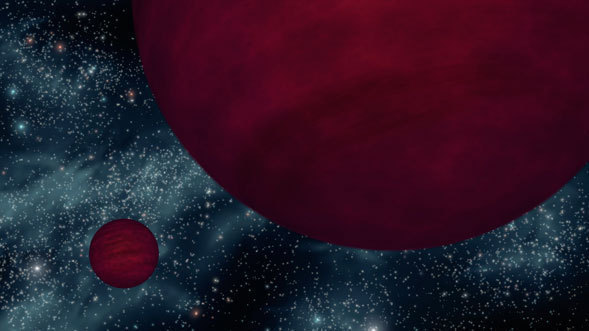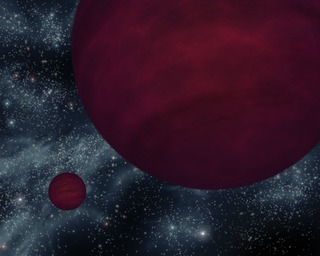
News Release • December 10th, 2008 • ssc2008-22 •
It's a tie! The new record-holder for dimmest known star-like object in the universe goes to twin "failed" stars, or brown dwarfs, each of which shines feebly with only one millionth the light of our sun.
Previously, astronomers thought the pair of dim bulbs was just one typical, faint brown dwarf with no record-smashing titles. But when NASA's Spitzer Space Telescope observed the brown dwarf with its heat-seeking infrared vision, it was able to accurately measure the object's extreme faintness and low temperature for the first time. What's more, the Spitzer data revealed the brown dwarf is, in fact, twins.
"Both of these objects are the first to break the barrier of one millionth the total light-emitting power of the sun," said Adam Burgasser of the Massachusetts Institute of Technology, Cambridge. Burgasser is lead author of a new paper about the discovery appearing in the Astrophysical Journal Letters.
Brown dwarfs are the misfits of the cosmos. They are compact balls of gas floating freely in space, but they are too cool and lightweight to be stars, and too warm and massive to be planets. The name "brown dwarf" comes from the fact that these small, star-like bodies change color over time as they cool, and thus have no definitive color. In reality, most brown dwarfs would appear reddish if they could be seen with the naked eye. Their feeble light output also means they are hard to find. The first brown dwarf wasn't discovered until 1995. While hundreds are known today, astronomers say there are many more in space still waiting to be discovered.
The newfound dim duo of brown dwarfs, while notable for their exceptional faintness, will probably not be remembered for their name. They are called 2MASS J09393548-2448279 after the Two Micron All-Sky Survey, or "2MASS," the mission partially funded by NASA that first detected the object in 1999.
Astronomers recently used Spitzer's ultrasensitive infrared vision to learn more about the object, which was still thought to be a solo brown dwarf. These data revealed a warm atmospheric temperature of 565 to 635 Kelvin (560 to 680 degrees Fahrenheit). While this is hundreds of degrees hotter than Jupiter, it's still downright cold as far as stars go. In fact, 2MASS J09393548-2448279, or 2M 0939 for short, is one of the coldest star-like bodies measured so far.
To calculate the object's brightness, the researchers had to first determine its distance from Earth. After three years of precise measurements with the Anglo-Australian Observatory in Australia, they concluded that 2M 0939 is the fifth-closest known brown dwarf to us, 17 light-years away toward the constellation Antlia. This distance, together with Spitzer's measurements, told the astronomers the object was both cool and extremely dim.
But something was puzzling. The brightness of the object was twice what would be expected for a brown dwarf with its particular temperature. The solution? The object must have twice the surface area. In other words, it's twins, with each body shining only half as bright, and each with a mass of 30 to 40 times that of Jupiter. Both bodies are one million times fainter than the sun in total light, and at least one billion times fainter in visible light alone.
"These brown dwarfs are the lowest power stellar light bulbs in the sky that we know of," said Burgasser. "And like low-energy fluorescent light bulbs, they emit most of their light in a narrow range of wavelengths, in this case in the infrared."
According to the authors, there are even dimmer brown dwarfs scattered throughout the universe, most too faint to see with current sky surveys. NASA's upcoming Wide-Field Infrared Survey Explorer mission will scan the entire sky at infrared wavelengths, and is expected to uncover hundreds of these inconspicuous characters.
"The holy grail in the study of brown dwarfs is to find out how low you can go in terms of temperature, mass and brightness," said Davy Kirkpatrick, a co-author of the paper at NASA's Infrared Processing and Analysis Center at the California Institute of Technology, Pasadena. "This will tell us more about how brown dwarfs form and evolve."
Other authors of this paper are Chris Tinney of the University of New South Wales, Australia; Michael C. Cushing of the University of Hawaii, Manoa; Didier Saumon of the Los Alamos National Laboratory, NM; Mark S. Marley, NASA Ames Research Center, Moffett Field, Calif.; and Clara S. Bennett of the Massachusetts Institute of Technology.





